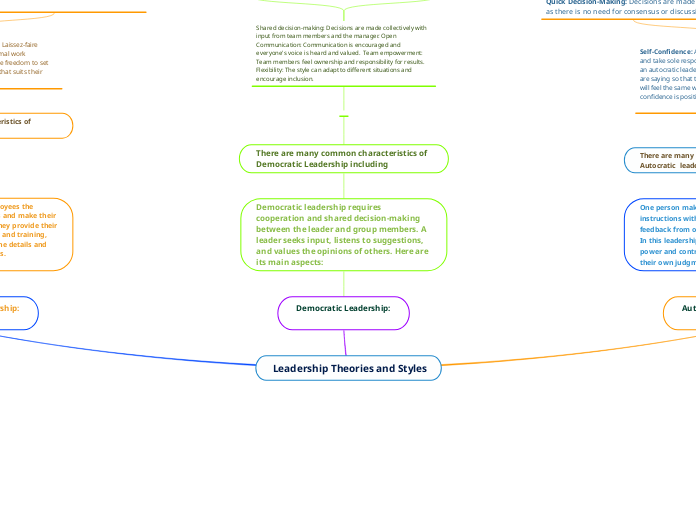Leadership Theories and Styles
Laissez-Faire Leadership:
Laissez-faire managers offer employees the freedom to run their own stations and make their own decisions. When necessary, they provide their staff with help, direction, counsel, and training, but they rely on them to handle the details and carry out their tasks and initiatives.
There are many common characteristics of Laissez-Faire Leadership including
1. very little direction from leaders: Laissez-faire leaders often create a flexible and informal work environment where employees have the freedom to set their own schedules and work in a way that suits their preferences, within certain boundaries.
2. Employees are capable of making decisions:
3. It will be expected that individuals manage their own issues.
Democratic Leadership:
Democratic leadership requires cooperation and shared decision-making between the leader and group members. A leader seeks input, listens to suggestions, and values the opinions of others. Here are its main aspects:
There are many common characteristics of Democratic Leadership including
Shared decision-making: Decisions are made collectively with input from team members and the manager. Open Communication: Communication is encouraged and everyone's voice is heard and valued. Team empowerment: Team members feel ownership and responsibility for results. Flexibility: The style can adapt to different situations and encourage inclusion.
Compare and Contrast: Autocratic leadership is highly centralized, with decision-making power in the hands of one person, while laissez-faire leadership shares it among team members.
Democratic leadership achieves balance by involving everyone in the process. Autocratic leadership is effective, but it can stifle creativity and motivation. Laissez-faire leadership promotes autonomy but may lack direction.
Autocratic Leadership:
One person making decisions and delivering instructions without discussing or receiving feedback from others is known to be an autocrat. In this leadership style, the leader has complete power and control and often bases decisions on their own judgment and vision.
There are many common characteristics of Autocratic leadership style including
Self-Confidence: Autocratic leaders hold absolute power and take sole responsibility for all decisions. When you are an autocratic leader, you should be confident in what you are saying so that the people you expect to listen to you will feel the same way. It is seen to be positive when confidence is positively expressed.
Quick Decision-Making: Decisions are made swiftly as there is no need for consensus or discussion.
Strict Hierarchy: There is a clear hierarchy, and workers are required to follow through with all instructions.
